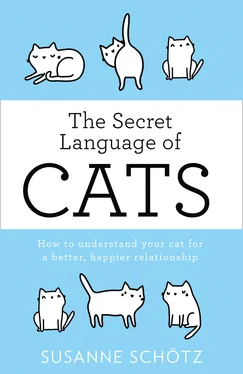1. Sounds produced with a closed mouth, the murmurs (purring, trilling)
2. Sounds produced when the mouth is first opened and then gradually closed (meowing, howling, yowling)
3. Sounds produced with a mouth held tensely open in the same position (growling, snarling, hissing, spitting, chattering, chirping)
Moelk operated on the assumption that the various acoustic patterns in the sounds signaled different messages, for example acknowledgment, bewilderment, request, greeting, demand and complaint.
Jennifer Brown and her colleagues Buchwald, Johnson and Mikolich investigated the sounds of both adult cats and kittens. They found acoustic similarities in various sounds produced in similar behavioral situations, as well as differences in sounds produced in different situations.
Between the 1950s and the 1970s, there were also a number of studies of laboratory cats. Due to the laboratory setting, these studies involved the analysis of unnatural (probably often desperate) sounds that were recorded in the sterile atmosphere of the laboratories where the cats were caged and probably starved before the recording sessions. Luckily, there are now more case studies that were conducted under humane circumstances, often in the private homes of the cats. There are now many scientific studies of cat sounds stemming from behavioral research (ethology) and zoology, as well as an increasing number of linguistic and phonetic studies.
Though there are more recent studies, many descriptions of the sounds of cats continue to refer to Mildred Moelk, her three main categories and her sixteen different sound patterns. I, too, am guided by Moelk in this book and describe most of her sound patterns. On top of those, I also include sounds that were described in other works and sounds which I have recorded and analyzed in my own studies. The categories (sound patterns) are organized according to their phonetic traits or features. Because of the great number of different variations, I have decided to describe only sound patterns that I have personally observed in my own or other cats. I have also recorded the vast majority of these sounds myself and have analyzed them using phonetic methods. I would like to invite you to listen to them yourself and maybe to compare them to the sounds made by your own cat. You will find the relevant links to the individual video and sound examples on my website at http://meowsic.info/catvoc.
In the following pages I will give you a brief overview of the most common cat sounds. A few have two or more names. Books, articles and websites on the topic sometimes use one word and sometimes use another to describe the same sound. Meowing, for example, is also sometimes described as miaowing, and howling is often described as yowling. Because it is likely that these names are used for the same type of sounds, I included the most common name for each sound type first and then included other common terms within brackets. A few examples also include transcriptions using the International Phonetic Alphabet. The individual phonetic symbols are explained in Tables 3, 4 and 5 on pages 260-265. Please do take a look and see if you know some of these sounds from your own cats.
1. Sounds produced with an open mouth
a. The Purr: A very low-pitched, sustained, relatively quiet, regular sound produced during both inhalation and exhalation: [↑hːr-̃ ↑rː̃h-↓hːr-̃ ↑rː̃h] or [↓hːʀ̃ː-↑ʀ̃ːh-↓hːʀː̃-↑ʀ̃ːh]. A cat purrs when it is content, hungry, stressed, in pain, as well as when it gives birth or is dying. Purring probably indicates something more like “I am no threat,” “please leave everything as it is,” or “keep on doing what you are doing,” than “I am content.” Mother cats and their young often communicate with purring, probably because it is a quiet sound that is hard for other predators to detect. Purring is also common among some large wild cats—one of the best known is the cheetah named Caine. Many cats can simultaneously purr and trill or meow.
b. The Trill(Chirr, Chirrup, Grunt, Murmur, Coo): A relatively short and often soft sound that is frequently rolled softly on the tongue. Trilling sounds somewhere between a purr and a meow, almost like a voiced rolled r (although sometimes a little harsh): mrrrh , mmmrrrt or brrh , which can be written in phonetic script as [mrː̃ h], [mːʀ̃ːut] or [bʀ̃ː]. A trill is used during friendly approach and greeting, when playing, and sometimes as an acknowledgment or confirmation (which might be interpreted as “yes, got it” or “thanks”). A trill can be varied in pitch and trilling, and has the following subcategories:
i. The Chirrup(Chirr): A more high- pitched trill, often with a tonal rise at the end of the sound.
ii. The Grunt(Murmur): A shorter and more low-pitched trill, often with level or falling tone.
iii. The Murmur(Coo): A soft nasal sound without any trilling or rolling r -sound, which sounds more like a soft [m] or murmuring sound.
It is not unusual for a trill to turn into a meow, thus producing a more complex sound: brrriu [brĩuw], brrmiau [bʀ̃ːmiau] or mrrriau [mhrː̃iauw]. Purring and trilling can also occur together.
2. Sounds made while the mouth is first opening and then closing
a. The Meow Sounds: This is one of the sounds used most frequently with us humans. It has a great number of different meanings and phonetic subcategories. Meowing mostly takes place with an opening mouth that then closes. I have identified the following subcategories based on their phonetic characteristics.
i. The Mew: A very high-pitched meow, often with the vowels [i] , [ɪ] and [e] , some times followed by a [u], i.e. [me], [wi] or [mIu]. Kittens often use this sound to get their mother’s help or attention. Adult cats may mew when they need the attention or help of their humans.
ii. The Squeak: A raspy, nasal, high-pitched and often short mew-like call, often with the vowels [ɛ] or [æ]. A squeak often ends with an open mouth: [wæ], [mɛ] or [ɛu]. Squeaks are often friendly requests for attention.
iii. The Moan: A somewhat dark (with acoustically low resonances) meow, often with the vowels [o] or [u]: i.e. [mou] or [wuæu]. A moan is often used by a cat that is either anxious, stressed or demanding something.
iv. The Meow(Miaow): A sound which often includes a combination of multiple vowels that often, but not always, produces the characteristic [iau] sequence, i.e. the typical meow sound. Meows are often directed at humans in order to gain their attention, and may sound like [miau], [ɛau] or [wαːʊ].
v. The Trill-Meow(Murmur-Meow): A combination of a trill and a meow sound. Often with a rising tone, which may sound like [mʀ̃hŋau] or [whrː̃ au].
b. The Howl(Yowl, Moan, Anger Wail): A long and often repeated sequence of extended vowel sounds, usually produced by gradually opening the mouth wider and closing it again. A howl may consist of a combination of vowels and semivowels, such as [ɪ], [ɨ], [ɤ] or [j], or [aʊ], [ɛʊ], [ɑʊ], [ɔɪ], or [ɑɔ], i.e. [awɔɪɛʊː], [jɪɨɛɑʊw] or [ɪːaʊaʊaʊaʊawawaw] with a rising and falling melody. It is used as a warning signal in aggressive and defensive (agonistic) situations, and is often merged or combined with growling in long sequences with slowly varying melody and loudness.
c. The Mating Call(Mating Cry): A long sequence of meow-like sounds, trill-meows and/or howls produced with an opening and then closing mouth by both female and male cats. The sound sometimes sounds a bit like a human child weeping and crying. Perhaps that is why humans often react instantly to this sound.
Читать дальше












